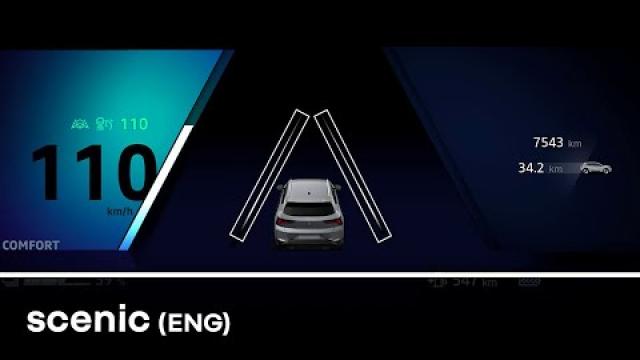Back to the list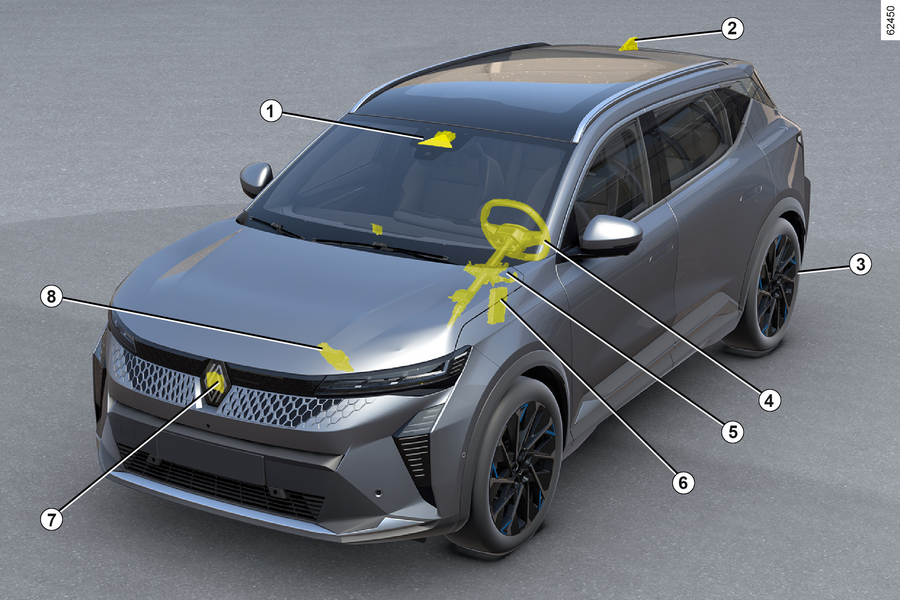
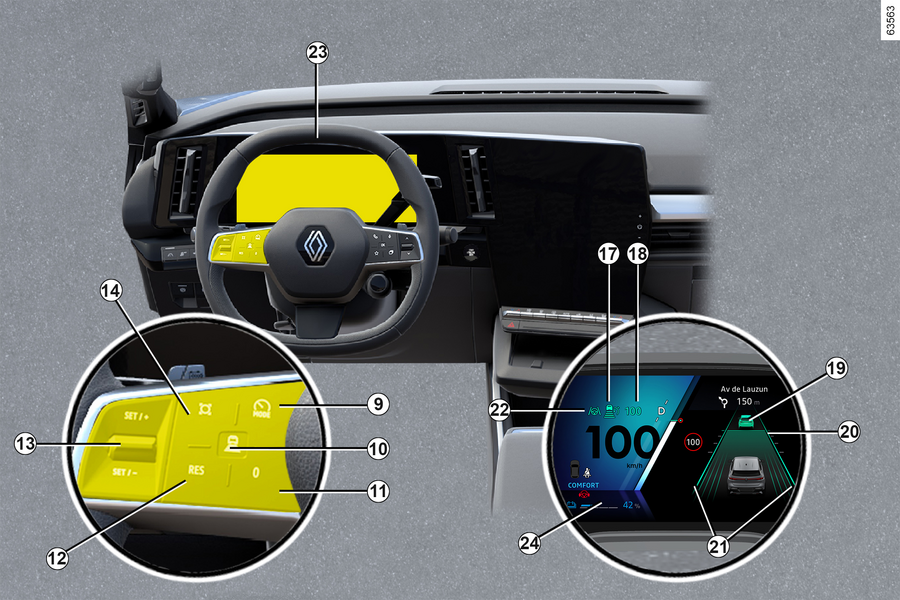
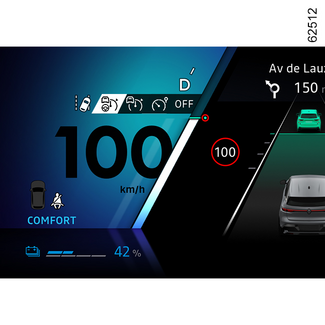
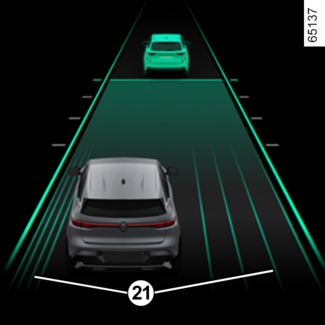
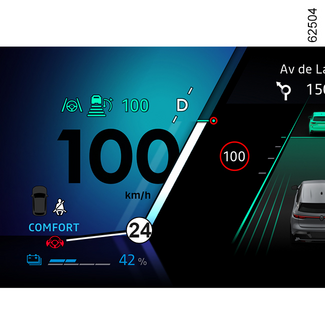
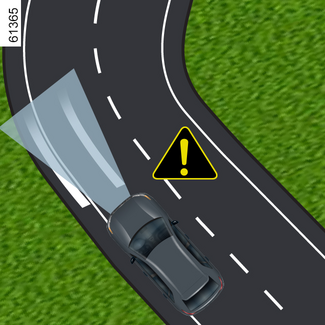
Active driver assist
Active driver assist
The "Active driver
assist" is a driving aid system for use outside built-up areas, on wide roads with visible
lines.
This system consists of the "Adaptive cruise control Stop and Go" function STOP AND GO ADAPTIVE CRUISE CONTROL and the "Lane Centring" function.
This system enables the driver to:
- maintain vehicle speed based on a previously stored speed;
- adjust the distance between their vehicle and the vehicle in front;
- direct the trajectory of the vehicle in the lane;
- adapt the vehicle speed to the speed shown on the road signs, automatically or after confirmation by the driver (depending on the vehicle).
The Stop and Go adaptive cruise control function.
Depending on the country and subscription, based on information from a radar, camera
or map data sent via a GSM connection, the Stop and Go adaptive cruise control makes it possible to maintain a selected speed, known as
the cruising speed, while keeping a safe distance from the vehicle in front in the
same lane.
The cruising speed can adjust automatically to a speed limit change (depending on
the country and subscription).
If the vehicle in front stops, the Stop and Go adaptive cruise control may brake your vehicle to a complete stop before setting
off again.
WARNING
Important: you should keep your feet near the pedals and your hands on the steering
wheel at all times to prepare for any event.
The system controls acceleration and deceleration of your vehicle using the engine
and braking system.
The Stop and Go adaptive cruise control function can be activated from 0 mph, according to conditions
on the road (traffic, weather, etc.).
It is represented by the  STOP AND GO ADAPTIVE CRUISE CONTROL symbol.
STOP AND GO ADAPTIVE CRUISE CONTROL symbol.
Note:
- the driver must observe the maximum speed limit and safe distances according to the legislation in the country where they are driving;
- the adaptive cruise control can brake the vehicle up to a third of the braking capacity. Depending on the situation, the driver may need to brake harder.
Tip
The Stop and Go adaptive cruise control does not trigger an emergency stop and its braking capability
is limited.
The Lane Centring function
Using information from a camera, the "Lane Centring" function manipulates the steering
system to direct the vehicle in the lane.
If the conditions allow it, the function is available between:
- 0 mph and a speed between 99 mph (160 km/h) and 112 mph (180 km/h) (depending on the version) with a vehicle in front;
or
- 37 mph (60 km/h) and a speed between 99 mph (160 km/h) and 112 mph (180 km/h) (depending on the version) without a vehicle in front.
The "Lane Centring" function is a comfort feature.
It is represented by the  warning light.
warning light.
Note: in the event of a sharp bend, the function's lateral retention capacities are limited
and require the driver to take immediate action on the steering wheel.
Additional information
Depending on the vehicle, the "Active driver
assist" function may be used with other driving aid functions.
Please note that:
- When the "Lane Centring" function is in adjustment mode, this will suspend the "Lane departure prevention" function if it has already been activated. When the "Lane Centring" function is not controlling the steering system, the "Lane departure prevention" function may be reactivated if conditions allow.
Location of components

- 1
- Camera
- Detects markings on the ground and the position of vehicles on the various traffic lanes.It receives information from the radar 6 and merges it with its own information to determine the trajectory and speed of the vehicle (acceleration/braking). Amongst other things, it controls the system activation/deactivation parameters (door opening status, etc.).Depending on the vehicle, it processes information to detect the presence of the driver's hands on the steering wheel.Make sure the windscreen is not obscured (by dirt, mud, snow, etc.).
- 2
- Aerial and maps(depending on the country and subscription)Road maps and certain driving conditions (roundabouts and cornering) are downloaded according to the journey taken by the vehicle. The system can anticipate deceleration following a change of the speed limit indicated on road signs, depending on the parameters selected by the driver.The system can also adjust the vehicle's speed when approaching a tight bend or roundabout.
- 3
- Electronic parking brakeIt the vehicle stationary under certain conditions.
- 4
- Capacitive sensorDepending on the vehicle, it detects hands on the steering wheel.
- 5
- Power-assisted steeringIt operates the front wheels to guide the vehicle trajectory according to the information transmitted by the computer 1.
- 6
- Engine computerIt controls and directs the engine to carry out the required acceleration.
- 7
- RadarCalculates the distance between your vehicle and the vehicle in front.The system's maximum range is approximately 150 metres. This may vary according to the road conditions (ground relief, weather conditions, etc.)Ensure that the radar area is not obstructed (dirt, mud, snow, a badly fitted front number plate), impacted, modified (including painting) or hidden by any accessory fitted on the front of the vehicle (on the grille or logo etc.).
- 8
- Active vehicle controlThis system provides information on vehicle dynamics to the computer 1 (speed, lateral acceleration, etc.) and acts on the braking system to control deceleration and to keep the vehicle stationary.
WARNING
The radar and camera zones must be kept clean and free of any tampering in order to
ensure the proper operation of the system.
Controls

- 9.
- Switch for selecting/deselecting the driving aids, depending on the vehicle:
- the Active driver assist;
- Adaptive Cruise Control;
- speed limiter;
- Off.
- 10.
- Safe distance settings
- 11.
- Puts the function on standby and stores the limited speed (0).
- 12
- Recall the stored cruising speed (RES).
- 13
- Upwards: activates, increases cruising speed or stores the current speed (SET/+).
- Downwards: activates, decreases cruising speed or stores the current speed (SET/-).
- 14
- Pop-up button (depending on the vehicle): adapts the speed setpoint to detected speed limits
DETECTION OF ROAD SIGNS
Displays on the instrument panel
- 17.
- Stop and Go adaptive cruise control function warning light
.
- 18.
- Stored cruising speed.
- 19.
- Vehicle in front.
- 20.
- Stored safe distance
- 21.
- Left-hand and right-hand line indicators
- 22.
- "Lane Centring" function warning light
.
Steering wheel 23
The driver must always keep their hands on the steering wheel.
If the driver turns the steering wheel with enough force, the "Lane Centring" function
is interrupted to enable the driver to regain control of the vehicle.
Under certain conditions (sharp bends, etc.) a vibration may be triggered on the steering
wheel to warn the driver that they must regain control of the vehicle.
If the driver does not handle the steering wheel (no hands are detected) the "Lane
centring" function is deactivated after several visible and audible alerts.
Activating/deactivating the "Active driver assist" function
Activating the function

To activate the function, press the switch 9 as many times as necessary to activate it.
The warning light 22 is displayed in grey on the instrument panel.
is displayed in grey on the instrument panel.
Then press the steering wheel control 13 upwards (SET/+) or downwards (SET/-).
The "Active driver
assist", consisting of the Adaptive cruise control Stop and Go and the "Lane Centring" function, is then activated.
The green warning light 22 and the left-hand and right-hand line indicators 21 are displayed on the instrument panel to confirm that the function is in operation
and directing your vehicle towards the centre of the lane.
and the left-hand and right-hand line indicators 21 are displayed on the instrument panel to confirm that the function is in operation
and directing your vehicle towards the centre of the lane.
You can interrupt the "Lane Centring" function at any time by forcefully turning the
steering wheel. As soon as you stop turning the steering wheel, the "Lane Centring"
function is reactivated.
Note: you must keep your hands on the steering wheel when using the "Lane Centring" function.
Under no circumstances should you take your hands off the steering wheel.
Deactivating the function
Press the switch 9. Deactivation of the function is confirmed by the disappearance of the warning light
22 and the right-hand and left-hand line indicators 21 from the instrument panel.
and the right-hand and left-hand line indicators 21 from the instrument panel.
Note: if the "Lane departure prevention" function was previously activated and the conditions allow, it will automatically
reactivate.
Adjusting the position in the lane
(depending on the vehicle)

To activate the position in the lane, the "Lane Centring" function must be in adjustment
mode, the green warning light 22 must be displayed on the instrument panel and the vehicle speed must be below 31
mph (50 km/h).
In these conditions, you can adjust your position in the lane by turning the steering
wheel slightly to the right or left, so that the vehicle shifts to the selected side
without the "Lane Centring" function being deactivated. As soon as your offset is
at least about 15 cm from the middle of the lane, without the vehicle approaching
less than about 30 cm from the edge of the lane, you have about 10 seconds to adjust
the offset precisely. The vehicle then remains in the offset position when you stop
exerting effort to turn the steering wheel. The lines 21 indicate the offset applied. To return to the centre of the lane, turn the steering
wheel slightly in the opposite direction, then stop trying once the vehicle has reached
the centre.
According to certain conditions (e.g. bend, speed), the vehicle may be re-centred
automatically.
"Lane Centring" function on standby
The "Lane Centring" function is put on standby automatically in the following cases:
- the system no longer detects the lines or only one line is detected in your lane;
- the lane is too narrow or too wide;
- the system does not detect any hands on the steering wheel;
- in some driving conditions (roundabout, intersection, the bend is too sharp, etc.);
- the vehicle speed is greater than approximately 99 mph or 112 mph (160 km/h or 180 km/h), depending on the vehicle;
- the vehicle speed is below approximately 30 mph (48 km/h), without a vehicle in front;
- the vehicle crosses a line;
- the system is temporarily disrupted (for example: camera obscured by dirt, mud, snow, condensation, etc.).
Certain actions carried out by the driver also suspend the "Lane Centring" function:
- activating the indicators;
- turning the steering wheel with enough force.
The function is confirmed to be on standby by the appearance of the grey warning light
22 and the left-hand and right-hand line indicators 21 on the instrument panel.
and the left-hand and right-hand line indicators 21 on the instrument panel.
WARNING
Important: you should keep your feet near the pedals and your hands on the steering
wheel at all times to prepare for any event.
Once the conditions are met, the function again directs the vehicle in the lane. The
warning light 22 and the left-hand and right-hand line indicators 21 are displayed in green on the instrument panel.
and the left-hand and right-hand line indicators 21 are displayed in green on the instrument panel.
Tip
You can affect the vehicle trajectory at any point by turning the steering wheel.
"Keep hands on steering wheel" warning

When the "Lane Centring" function no longer detects your hands on the steering wheel,
several warning levels will be triggered:
- after approximately 15 seconds, the "Keep hands on steering wheel" message appears in yellow on the instrument panel;
- after approximately 30 seconds, the "Keep hands on steering wheel" message appears on the instrument panel and the warning light 24
appears in red, accompanied by a gradually increasing sound signal;
- after approximately 35 seconds, if the driver does not put their hands on the steering wheel after the warning is displayed, an audible warning sounds continuously. The brakes are then briefly applied repeatedly to inform the driver that they must retake control of the vehicle by putting their hands on the steering wheel. If the driver does not respond, the "Active driver assist" activates the hazard warning lights and slows down the vehicle until it comes to a complete stop.
Tip
The driver can interrupt this manoeuvre at any time by placing their hands on the
steering wheel, braking or deactivating the "Active driver
assist".
- with the vehicle stopped, the gearbox in the P position, the hazard warning lights remain on, the warning light 24
switches off and the "Lane centering deactivated" message appears in red on the instrument panel to inform you. To reactivate the function, set the gear lever to D and push the steering wheel control 13 upwards (SET/+) or downwards (SET/-): the "Active driver assist" system (consisting of the "Stop and Go adaptive cruise control" and the "Lane Centring" function) is activated if the required conditions are met.
Tip
In the first two alert levels, when the system again detects the presence of the driver's
hands on the steering wheel, the system stops the alerts. The function continues to
direct the vehicle in the lane.
Note: in some situations, the "Lane Centring" function may no longer detect your hands
on the steering wheel and may emit an alert:
- the driver is holding the steering wheel very lightly;
- the driver is wearing gloves;
- ...
WARNING
Warning concerning the capacitive sensor: fitting any accessory on the steering wheel
is prohibited (protective cover, etc.).
In the case of a sharp bend

In the case of a sharp band, and depending on the vehicle speed, the function's side
retaining capacities will be limited and require the driver to carry out immediate
action on the steering wheel so that the vehicle remains in the lane.
If the driver does not intervene, the function triggers the vibration of the steering
wheel to signal that the vehicle is about to breach a line and that the driver needs
to carry out immediate action.
The warning light 22 and the left-hand or right-hand line indicator 21 concerned appear in red on the instrument panel.
and the left-hand or right-hand line indicator 21 concerned appear in red on the instrument panel.
If the vehicle crosses a line completely and moves out of its lane or if the bend
is too sharp, the "Lane Centring" function is put on standby.
The function is confirmed to be on standby by the appearance of the grey warning light
22 and the left-hand and right-hand line indicators 21 on the instrument panel.
and the left-hand and right-hand line indicators 21 on the instrument panel.
Tip
The "Lane Centring" function cannot assist the driver when negotiating a roundabout
or an intersection and may automatically switch to standby.
In all cases, the driver must always turn the steering wheel to manage the vehicle
trajectory under these driving conditions.
Operating faults
If an operating fault is detected in relation to the "Lane Centring" function, the
"Driving assist unavailable" or "Check Driving assist" message is displayed on the instrument panel and the function is deactivated.
Consult an approved dealer.
Warning
WARNING
The "Active driver
assist" is an additional driving aid. it can under no circumstances replace the driver's
responsibility to respect speed limits and safe distances and to be vigilant.
The driver must always be in control of the vehicle.
The driver must always adapt their trajectory and speed according to the surroundings
and driving conditions, regardless of system indications.
Except for lines delimiting lanes and the speed limit signs within the limits of the
system's detection capacity, the road sign information (other traffic signs, traffic
lights, pedestrian crossings, etc.) are not recognised by the system. These do not
trigger any alert or reaction by the system.
The "Active driver
assist" uses the "Stop and Go adaptive cruise control" and "Lane Centring" functions. The system should under no
circumstances be taken to be an obstacle detector or an anti-collision system.
Use the "Active driver
assist" exclusively outside built-up areas, on wide roads with visible lines.
It must not be used in heavy traffic, on winding or slippery roads (black ice, aquaplaning,
gravel) or during bad weather (fog, rain, side winds etc.).
There is a risk of accidents.
System servicing/repairs
- In the event of an impact, the radar and/or camera alignment may be changed and its operation may consequently be affected. Deactivate the system and consult an authorised dealer.
- Any work in the proximity of the radar and/or camera (replacements, repairs, windscreen modifications, paintwork etc.) must be carried out by a qualified professional.
Only an authorised dealer is qualified to service the system.
WARNING
Deactivating the system
You must deactivate the system if:
- the vehicle is travelling on a winding road;
- the vehicle is being towed (breakdowns);
- the vehicle is towing a trailer or a caravan;
- the vehicle is being driven in a tunnel or close to a metallic structure;
- the vehicle arrives at a toll point, a roadwork area or on a narrow lane;
- the vehicle is being driven up or down a very steep slope;
- the visibility is poor (glaring sun, fog, etc.);
- the weather conditions are poor (rain, snow, side winds, etc.);
- the vehicle is being driven on a slippery road surface (rain, snow, gravel, etc.);
- the camera area has been damaged (e.g. interior or exterior windscreen area); the windscreen is cracked or distorted;
- the radar area has been damaged (impacts, etc.);
- the surface of the steering wheel is damaged or damp.
In the event of the system behaving abnormally, deactivate it and consult an authorised
dealer.
WARNING
Some conditions can disrupt or damage the system operation, for example:
- obstruction of the windscreen or the radar area (by dirt, ice, snow, condensation etc.) Frequently check the cleanliness and condition of the windscreen, front wiper blades and front bumper;
- a complex environment (tunnel, etc.);
- poor weather conditions (snow, heavy rain, hail, black ice, etc.);
- poor visibility (night, fog, etc.);
- poor contrast between the vehicle preceding it and the surrounding area (e.g. white vehicle in a snowy area, etc.);
- being dazzled (glaring sun, lights of vehicles travelling in the opposite direction; etc.);
- narrow, winding or undulating road (tight bends, etc.);
- the tar lines detected as a line by the system;
- narrowing/widening lanes;
- road markings which are worn, lacking in contrast or very widely spaced from one another (lines partially erased; etc.);
- multiple markings on the road (roadworks area, slip roads connecting to adjacent motorways, hard shoulder, etc.);
- road signs that do not include an arrow, located on a motorway exit;
- an area with low connectivity that makes it impossible to geolocate the vehicle, or maps that are not up-to-date;
- a vehicle with a significant difference in speed;
- use of mats not adapted to the vehicle. On the driver's side, only use mats suitable for the vehicle, attached with the pre-fitted components, and check the fitting regularly. Do not lay one mat on top of another. There is a risk of wedging the pedals.
In these cases:
- Risk of unwanted braking or acceleration.
- Risk of unwanted, incorrect correction or no correction of trajectory.
Many unforeseen situations may affect the system operation. Certain objects or vehicles
that can appear in the camera or radar detection zone may be interpreted by the system
incorrectly, possibly leading to inappropriate acceleration or braking.
You should always be attentive to sudden events that might occur while you are driving.
Always maintain your vehicle under control by keeping your feet near the pedals and
your hands on the steering wheel, so that you are ready to act in any event.
